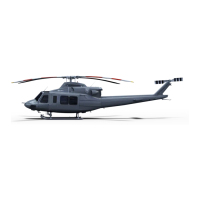BHT-412-MM-2
5-00-00
Page 4 Rev. 19 30 AUG 2013
Export Classification C, ECCN EAR99
Every calendar and hourly inspection is a thorough
visual inspection to determine the airworthiness of the
helicopter and the components. Qualified persons
must do the inspections in accordance with quality
standard aircraft practices and the applicable
maintenance manuals. Bell Helicopter Textron
considers that it is mandatory to obey all the
applicable Alert Service Bulletins (ASB) and the
Airworthiness Directives (AD).
Component operating time records are necessary for
components that have scheduled maintenance
procedures, which are different from those of the
airframe. It is the owner/operator’s responsibility to
keep the Historical Service Records (HSR) for the
applicable component and to do the necessary
maintenance procedures.
Before each inspection, remove or open the
necessary cowlings, fairing, inspection doors, and
panels.
5-2. INSPECTION REQUIREMENTS
This manual does not include specific inspections
required by the FAA or other government regulatory
authorities. These specific inspections are given by
your government regulatory authority. Refer to their
requirements for these specific inspections.
The owner/operator of the helicopter is responsible for
the maintenance done on the helicopter. It is the
owner.operator’s responsibility to:
1. Establish, maintain, and review the log books for
discrepancies.
2. Make sure the Alert Service Bulletins (ASB), the
Airworthiness Directives (AD), and the special
inspections are done when they are required to be
done.
3. Make sure the scheduled inspections, the special
inspections, and the required tests for all of the
installed kits are complied with.
4. Make sure all parts and components for which
Historical Service Records are required have
documented traceability to their original installation in
the helicopter.
ALL PARTS REMOVED, DUE TO
REACHING THEIR LIMITS OR AS A
RESULT OF AN ACCIDENT/INCIDENT
INSPECTION AND DEEMED
UNAIRWORTHY, SHALL BE
PERMANENTLY MARKED AS SCRAP OR
PHYSICALLY DESTROYED TO THE
EXTENT THAT THERE IS NO CHANCE
OF REPAIR OR INSTALLATION ON ANY
HELICOPTER OR COMPONENT.
5. Make sure all limited life parts that have
completed their published operating limits are
replaced.
6. Make sure all of the components that have
completed their published overhaul periods are
overhauled.
7. Make sure all of the maintenance that is done on
the helicopter is done by an approved maintenance
organization.
The maintenance organization/person doing the
maintenance is responsible for the quality of the
maintenance done.
The owner/operator may choose to ask the
maintenance organization/person doing the
maintenance to perform the tasks listed by prior
arrangement through a separate formal agreement.
5-3. CRASH DAMAGE
Because of the many possible combinations that can
result from crash damage, it is not possible to include
the specific repair tasks in this category. The
helicopter mechanic must make an analysis of the
crash damage for each situation. Do the repair in
accordance with the degree of damage to the specific
part and the applicable repair procedures in this
manual. Call Product Support Engineering with your
analysis of the crash damage.
5-3A. TYPES OF INSPECTIONS
1. The maintenance procedures may include
scheduled inspections, special inspections, conditional

